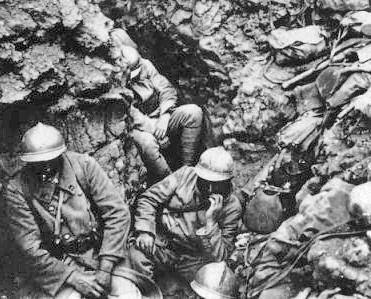TRENCH WARFARE LIFE: PART I

The words that I’ve heard personally trench warfare life from the many World War I veterans that I have interviewed describing what it was like to live in the trenches would be: “disgusting, wet, filthy, inhumane.”
First, the trenches were never meant to be lived in permanently for 4 years! In the beginning they were simply small fox holes for 1 or 2 men. However, after a few months, these fox holes were merged into long, well-defended fortifications and cement bunkers, to defend against the heavy artillery raining down upon the soldiers, and deadly machine gun fire. Eventually—each side believed–they would break out of the stalemate into open warfare again. Secondly, the water table varies across France and especially Belgium—a low lying country—and so when digging 8 to 12 feet down in the lower areas, flooding was a major problem: Especially for the Allies. Why? The fact that Germany made the decision to pull back to favorable positions after the initial opening battles of the invasion of France, allowed the German army to occupy the high ground (always a preferred position in battle).

Therefore, WWI British and French soldiers in Flanders—the super low-laying area that spanned both countries—experienced the worst of this type of flooding on the Western Front (see photo). This situation left many tens of thousands of men with a terrible condition called trench foot.
Trench Warfare: the Daily Grind
As World War I continued to grind along as a defensive struggle, life in the trenches became more routine. Here is a basic outline of a day in the life of a regular soldier:
1. 5am–The order “Stand-to-Arms”—because most attacks occurred just before sunrise/sunset, all men were “battle-ready” on the “fire-step.”
2. 5:30am—The order to “Stand-Down” was given and the men were fed, and then began their duties for the day.
3. Duties–As all work had to be done inside the trenches, or down in the dugouts to avoid being shot by a sniper, or observed by the new invention—the airplane—rarely did anyone work outside the trench. Other work could be repairing the duckboards (the wooden platforms that covered the floor of the trench to keep the men’s shoes from becoming wet), filling sandbags, cleaning the latrines, and repairing any damage to the trench or dugouts.
4. Some men could grab an hour or so of sleep, play cards, write letters and add to their personal journals.
5. Food was brought up from the rear, usually in large kettles hung on two long wooden poles. It was generally cold and dirty. Among the British troops, rum was distributed at certain times as a morale booster.
6. 6pm—The “Stand-to-Arms” was once again given, to be prepared for a twilight attack.
7. 6:30pm—the “Stand Down” order was given.
8. During the night all soldiers were awake to defend against a frontal assault. Also, repair parties would venture into No Man’s Land to repair the barbed-wire, and small raiding patrols were sent out to search for enemy patrols, probe their defenses or actually raid their trench for prisoners. Also, replacement troops for those ill, wounded or killed were brought up under cover of darkness.

This is a typical trench on the Western Front.

Trench Conditions

As can be expected, living in crowded, wet and extremely dirty conditions within a dirt-lined trench, the average soldier was exposed to a plethora of dangerous health conditions. To make matters worse, soldiers served 8 days in the front-line trench, then 4 days in the reserve trench. Finally, after 12 days they were sent out of the trenches to a rest area to shower, de-louse (get rid of their cooties), receive a clean uniform, and get some much-needed rest.
The major cause of death and injury while living in the trenches was artillery fire. Every day the enemy would lob a few shells over just to make sure you knew he was still there, trying to kill you. However, one of the greatest problems of trench warfare is living in the trenches where the following threats brought about by the inherent unsanitary conditions:

1. Lice—Called “cooties” by the soldiers, these body lice were found in all of the trenches, and would never be rid of. Their feces also carried “trench fever” which brought on headaches, relapsing fevers, lethargy, rashes and enlargement of the spleen. It is estimated that 1 million allied soldiers were infected during the war.
2. Rats—A major problem affecting almost every soldier involved in trench warfare were rats, big rats, usually the size of a house cat. With plenty of food and water prevalent in the trenches, rats were one of the main concerns of every soldier. Usually they would hear the rats moving around at night looking for scraps of food, or rummaging around the empty tins that the soldiers had simply thrown out towards No Man’s Land. Even worse, if a man was wounded and could not defend himself, rats would crawl into his coat to eat any food there. Eventually 500,000 cats were brought in to catch the rats. However, this introduced fleas to the troops as well, Additionally, terrier dogs were brought in as well. For some soldiers it became a game of how many rats you could kill. As an example of how many rats there were tormenting the men, 8,000 rats were caught by a corps of troops in just 1 night!


[To be continued in: Part II: Trench Warfare Life]
